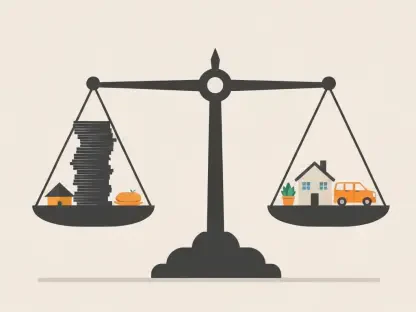In an age where technological evolution is happening at lightning speed, virtual banking stands out as one of the most transformative changes in the financial sector. By 2024, it is expected that nearly 2.5 billion people globally will be relying on virtual banking services, making it evident that this new wave of branchless banking is here to stay. This growth can be attributed to the unmatched convenience, accessibility, and efficiency that digital platforms provide, allowing users to conduct their banking transactions seamlessly from the comfort of their smartphones. As we look ahead to 2025, examining the trends and statistics surrounding virtual banking gives us a clearer picture of how digital finance will dominate the future landscape.
The Rise of Virtual Banking
The accelerated shift from traditional brick-and-mortar banking to online virtual banking could be seen as a pivotal moment in the financial industry’s history. With an estimated 2.5 billion people projected to use virtual banking services by 2024, this move signifies a considerable departure from the long-established norms of traditional banking. One significant driver behind this trend is the accessibility and convenience offered by digital platforms, particularly as these platforms allow banking transactions to be managed entirely through smartphones.
Mobile banking is a particularly notable aspect of this virtual banking rise. By the end of 2024, it’s predicted that there will be a staggering 5.5 billion mobile banking users globally. This highlights the pivotal role that mobile technology plays in contemporary financial management. The days of standing in long lines at bank branches are fast giving way to quick, efficient, and secure financial dealings conducted on mobile devices. The convenience of managing money on the go is revolutionizing how people interact with their banks, making the need for physical bank branches increasingly obsolete.
Economic Impact and Market Growth
The economic implications of this shift toward virtual banking are nothing short of monumental. In 2023 alone, digital banking transactions reached an impressive $8 trillion. Projections suggest that this figure will escalate further to $9.2 trillion by 2024. This burgeoning growth underscores the integral role digital finance now plays in the broader global economic landscape. The transition from traditional banking methods to digital alternatives not only streamlines operations for financial institutions but also provides a more agile and responsive service to users.
Other indicators of market growth reinforce this picture. The digital payments market, bolstered significantly by virtual banking, is on an upward trajectory, aiming for a remarkable $14 trillion valuation by 2027. This growth trajectory is fueled by the increasing affinity for digital payment methods. These methods offer users greater security and unparalleled convenience compared to conventional payment approaches. As more consumers and businesses embrace these innovations, the global economy moves closer to a predominantly digital financial ecosystem that promises efficiency and enhanced security in daily transactions.
Neobanks and Digital Wallets
Neobanks represent a new frontier in the banking industry, emerging as a completely digital option that operates without physical branches. With around 400 million users globally by 2023, neobanks have seen significant growth, a figure projected to rise by 25% in 2024. These banks offer various services, including savings and checking accounts, loans, and investment options accessible entirely through user-friendly mobile applications. Their pure digital nature provides a level of convenience and accessibility that traditional banks can’t match, positioning them as a strong alternative in the modern banking landscape.
Digital wallets are another crucial component within the virtual banking infrastructure. In 2023, digital wallets generated an impressive $800 billion in revenue globally, with projections to reach $1 trillion by 2025. Digital wallets provide a comprehensive solution for users, allowing them to store and manage their money digitally, make payments, and transfer funds using their smartphones. This surge in digital wallet usage underscores the growing shift toward digital financial management solutions, driven by the desire for more convenient, secure, and efficient ways to handle money.
Changing Customer Preferences
Customer preferences in the banking sector are undergoing a significant transformation, with a noticeable shift toward digital-first solutions. Millennials and Generation Z, in particular, are leading this change. A staggering 90% of Millennials and 85% of Generation Z prefer to use online or mobile banking exclusively. This shift reflects a broader trend toward the need for accessible, on-the-go financial services that can be operated from anywhere, emphasizing the role of convenience in modern banking.
In contrast, approximately 40% of Baby Boomers still cling to traditional banking methods, showcasing a generational divide in banking preferences. However, this number is gradually decreasing as older adults become more comfortable with using digital technology. The benefits of virtual banking—such as the ability to avoid physical branches, effortless money management, and time-saving features—are becoming apparent to older generations, demonstrating a slow but steady move toward greater digital banking adoption.
Technological Integration
The technological advancements at the core of virtual banking are pivotal to its ongoing evolution and success. AI-driven chatbots are one such innovation, resolving up to 80% of basic banking inquiries on digital platforms. This development enhances the customer service experience, providing quick and accurate responses while reducing operational costs for banks.
Biometric security features have become an industry standard for accessing virtual banking platforms. By 2023, around 45% of virtual banking customers were using biometric technology, such as facial recognition, to log into their accounts. This added layer of security helps to protect users’ personal and financial information, fostering greater trust and confidence in digital banking solutions.
Blockchain technology has also emerged as a critical player in the virtual banking sector. In 2023, the adoption of blockchain technology saw a 28% increase, which significantly boosted transaction security and enabled the creation of new digital assets. Blockchain’s ability to provide transparent, secure, and tamper-proof transactions makes it an invaluable tool in the continued evolution of virtual banking.
Cybersecurity and Fraud Prevention
As the adoption of virtual banking continues to rise, so does the need for robust cybersecurity measures. Virtual banks recognize the importance of protecting their customers’ data and are projected to increase their cybersecurity investments by 20% in 2024, reaching a total of $16 billion. These investments are essential in safeguarding sensitive information and preventing cyberattacks, which remain a significant concern in the digital age.
One common security measure among digital banks is multi-factor authentication (MFA), with 90% of institutions implementing this technology. MFA adds an extra layer of security by requiring users to provide two or more verification factors to access their accounts. Additionally, AI-powered fraud detection systems have proven to be highly effective, reducing transactional fraud by 40% and preventing an estimated $2 billion in losses. These measures are crucial in maintaining the integrity and reliability of virtual banking platforms and ensuring a secure user experience.
Transformation from Traditional to Digital Banking
The shift from traditional to digital banking is clear, particularly in the closure of physical bank branches. In 2023, over 2,500 branches were closed in the United States alone, driven by the increasing preference for online banking. This transition is partly due to the cost savings that digital platforms offer to financial institutions. As the operational costs associated with maintaining physical branches decrease, banks can provide more affordable services, such as lower or zero-fee accounts.
Digital banking also offers significant benefits for underserved populations who may have limited access to traditional banking services. By eliminating the need for physical branches, digital banking makes financial services more accessible to a broader audience. This inclusive approach is reshaping the financial landscape and providing new opportunities for individuals and businesses alike.
User Demographics and Global Adoption Rates
The adoption of virtual banking varies significantly across different regions and demographics. The Asia-Pacific region is leading the way, with 1.4 billion users expected by 2024. This rapid growth is driven by the region’s large population and increasing internet penetration, making digital banking more accessible to a wider audience.
In the United States, virtual banking is expected to see significant adoption, with projections indicating that 82% of adults will use digital banking services by 2024. This widespread adoption highlights the growing reliance on digital solutions for financial management. Small businesses are also rapidly transitioning to digital banking, driven by the need for remote access to financial services and the convenience of managing finances online.
Revenue and Profitability
The global digital banking sector is experiencing robust revenue growth, reaching $1.3 trillion in 2023 with an expected increase to $1.5 trillion by 2024. This growth is a testament to the rising popularity of virtual banking solutions and their ability to generate significant revenue. Virtual credit card usage is also on the rise, with projections indicating that it will generate $350 billion in revenue globally by 2026. This trend underscores the growing demand for digital financial products and services catering to a tech-savvy user base.
The revenue growth in the digital banking sector is driven by several factors, including the expanding user base, technological advancements, and the increasing adoption of digital payment methods. As more consumers and businesses embrace digital banking solutions, the sector is poised for continued growth and profitability.
Technological Innovations
Technological innovations are at the heart of the virtual banking revolution. Artificial intelligence (AI) plays an increasingly crucial role in enhancing customer service and reducing operational costs. By 2023, 75% of banks were using AI to streamline their services and provide a more personalized banking experience. AI-driven solutions, such as chatbots, predictive analytics, and automated financial planning, are transforming how banks interact with their customers and manage their operations.
Moreover, the integration of 5G technology into banking apps is revolutionizing service delivery. 5G technology offers faster, more reliable internet connections, enabling seamless and efficient financial transactions. This advancement enhances the user experience, making digital banking more appealing to a broader audience and further driving its adoption.
Main Findings
The future of banking is unequivocally digital, driven by a robust trend toward neobanks and digital platforms, particularly among Millennials and Generation Z. Technological advancements, such as AI, blockchain, biometric security, and 5G, play a central role in the growth and customer satisfaction in virtual banking. Increased cybersecurity measures and regulatory compliance are essential as digital banking continues to expand, ensuring customer data protection and fraud prevention. The economic impact of virtual banking is significant, supporting a thriving digital payments market and driving revenue growth for financial institutions globally. Despite the digital trend, there is a gradual adaptation among older generations, indicating a slower but eventual shift toward digital banking solutions.
Conclusion
In a world where technology evolves rapidly, virtual banking emerges as a significant change in the financial sector. By 2024, it’s expected that almost 2.5 billion people worldwide will depend on virtual banking services. This indicates that branchless banking is not just a trend but a lasting shift. The exponential growth of digital banking can be credited to its unparalleled convenience, accessibility, and efficiency, allowing users to handle their financial transactions effortlessly from their smartphones.
Virtual banking’s appeal lies in its ability to offer a seamless banking experience, eliminating the need to visit physical branches. Users can check balances, transfer funds, pay bills, and even apply for loans—all from a mobile app. This evolution is driven by advanced security features, user-friendly interfaces, and the growing trust in digital platforms.
As we approach 2025, looking into the trends and data regarding virtual banking helps us understand how digital finance is set to dominate the forthcoming financial landscape. Increased reliance on artificial intelligence and machine learning to enhance customer service, along with blockchain technology for secure transactions, are some key trends shaping the future of virtual banking. This shift represents not just an upgrade in convenience but a fundamental transformation in how we understand and engage with financial services, ensuring that virtual banking will play a pivotal role in the economic landscape of the future.









